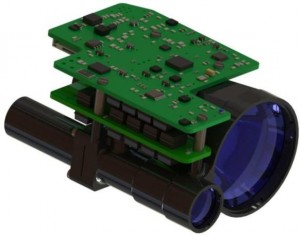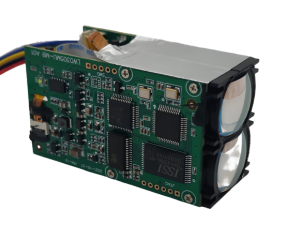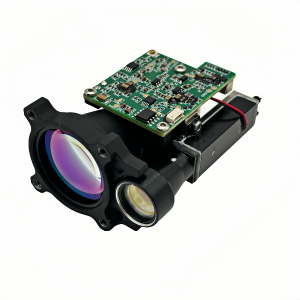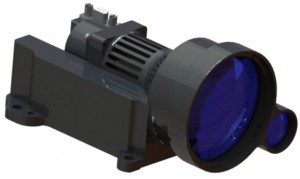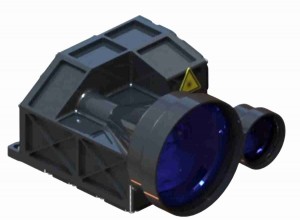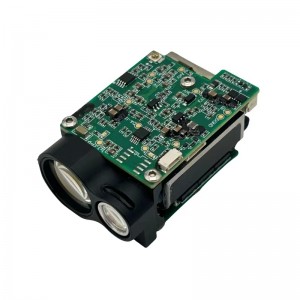Laser Rangefinder Module 10K1A
Product description
1.1 Product functions
- lLaser ranging function;
- Power-on self-test function;
- First and last target selection function;
- Distance gating function;
- Set the automatic ranging interval function;
- Cumulative laser emission times function;
- Power supply polarity reverse protection.
1.2 Product description
The main components of laser rangefinder products are as follows:
- Control and information processing circuit components;
- Laser power circuit components;
- Receive and transmit components.
The composition diagram is shown in Figure 1.
Figure 1 Schematic diagram of product composition
1.3 Mechanical and optical interfaces
The overall dimensions of the optical-mechanical interface of the laser rangefinder are shown in Figure 2.
Figure 2 Optical-mechanical interface diagram
1.4 Electrical interface
The electrical interface requirements are as follows:
l Power supply voltage: 10V~14V;
l Average power consumption: ≤5W;
l Standby power consumption: ≤1.5W;
The host computer uses the A1257H-10P connector to achieve cross-link testing with the rangefinder A1257WR-S-10P connector. The pin definitions of the power supply and communication port of the rangefinder are shown in Table 1.
Table 1 Definition of power supply and communication port pins on the rangefinder side
|
Pin number |
Label |
Characteristic |
Transmission direction |
Signal source or purpose |
|
1 |
GND |
|
—— |
serially |
|
2 |
RS422_RX_N |
|
I |
Rangefinder receiving end- |
|
3 |
RS422_RX_P |
|
I |
Rangefinder receiver+ |
|
4 |
RS422_TX_N |
|
O |
Rangefinder sending end- |
|
5 |
RS422_TX_P |
|
O |
Rangefinder transmitter+ |
|
6 |
NC |
|
—— |
spare |
|
7 |
NC |
|
—— |
spare |
|
8 |
NC |
|
—— |
spare |
|
9 |
P- |
|
—— |
power supply, ground |
|
10 |
P+ |
|
—— |
Power supply, 10V~14V |
Figure 3 Location of connector pin 1
1.5 Software
1.5.1 Interface Overview
It is connected to the laser rangefinder through the RS422 serial interface. The system sends control commands to the laser rangefinder through the serial port and receives the status and self-test information of the laser rangefinder.
1.5.2 Communication interface
The data transmission between the distance measuring machine and the host computer includes the following contents:
- Control commands: including 1Hz, 5Hz ranging instructions, query instructions, etc.;
- Return data: including distance information, ambient temperature, rangefinder status, etc.
The data exchange between the distance measuring machine and the host computer uses the RS422 bus, and its characteristics are as follows:
- Baud rate: 19200;
- Byte structure: low bit first, high bit last;
- Byte composition: 1 start bit, 8 data bits, no parity, 1 stop bit.
1.5.3 Commonly used ranging commands
1.5.3.1 Control command information received by the rangefinder
The format of the command frame sent by the control system to the ranging machine is shown in Table 2.
Table 2 Control command information received by the rangefinder
|
Byte0 |
Byte1 |
Byte2 |
Byte3 |
Byte4 |
Byte5 |
|
0xb7 |
0xb8 |
Comm |
DatH |
DatL |
Bak |
One frame of data contains 6 bytes, 0xb7 and 0xb8 are the start bytes, Comm is the command, DatH is the high byte of data, DatL is the low byte of data, and bak is the reserved byte.
Definition of Comm:
0x01: Automatic ranging
After receiving this command, the rangefinder will continuously measure distance at the set interval.
0x02: End automatic ranging
0x03: Set the gating distance
Byte3 is the high byte of the strobe distance, and byte4 is the low byte of the strobe distance.
0x04: Set the ranging interval during automatic ranging
Byte3 is the high byte, byte4 is the low byte; the data is expanded 100 times and sent. For example: if you want to emit a laser once every 4 seconds during automatic ranging, then send data 400; if you want to emit a laser once every 5 seconds, send data 500. (After powering on, the default repetition frequency of the rangefinder is 1s/time).
0x05: First and last target selection
The destination of the output depends on the value of DatH, which is defined as follows:
DatH=0:
Output first target
DatH=1:
Target in output
If there is only one target, this target is output; if there are two targets, the last target is output; if there are three targets, the intermediate target is output.
DatH=2:
Output final target
If there is only one target, this target is output; if there are two or more targets, the last target is output.
Note: You can set the first, middle and last before ranging, and output the corresponding distance value according to the setting of the first, middle and last during ranging; you can also call the last measurement by setting the first, middle and last command after ranging. distance results. Example: If there are three targets of 5km, 8km, and 10km respectively, and the last target output is set before ranging, the output distance value after ranging is 10km; if you want to extract the first target, send 0xb7, 0xb8, 0x05 ,0x00,0x00 command, after the rangefinder receives this command, it outputs 5km data.
Precautions for using the first and last target function:
This ranging module has a gating function and a first, middle and last target selection function. When using the first, middle and last selection function, the gating distance needs to be set to the default distance of 40m or less than 40m (the power-on default is 40m).
0x07: Single ranging
After receiving this command, a ranging measurement is performed.
Note: In order to reduce power consumption, the rangefinder is usually in standby mode. When the rangefinder receives the ranging command, it starts the laser power supply and APD power supply. This process takes about tens of ms. After the power supply is stable, the distance measurement is performed. After the distance measurement is completed and the results are sent to the host computer, it immediately enters the standby mode.
0x17: Reading laser times
After receiving this command or powering on, the rangefinder sends the cumulative number of lasers to the host computer.
0xf8: Write error correction value
DatH is the error correction value for over 400m, DatL is the error correction value for 50m to 90m, and BAK is the error correction value for 90m to 400m. The error is magnified 10 times and sent out, that is, the resolution is 0.1m.
For example: if the value is set to 1, 0.1m will be added to the measured value; if the value is -10, 1m will be subtracted from the measured value.
Setting method: First read the original error correction value, and then increase or decrease the corresponding value based on the original revised value based on the measurement results.
For example: the true value is 100m, the test result is 99m, and the reading error setting value is -5, then add 10 to -5, and the new setting value is 5; if the test result is 101m, then add 10 to -5 Subtract 10 from the basic value, and the new set value is -15.
0xF9: Read error correction value
After receiving this command, the distance measuring machine sends the bound error correction value to the host computer.
1.5.3.2 Range measuring machine returns data
The format of the data frame sent by the ranging machine to the host computer is as shown in Table 3:
Table 3 Data returned by the rangefinder
|
Byte0 |
Byte1 |
Byte2 |
Byte3 |
Byte4 |
Byte5 |
Byte6 |
Byte7 |
|
0xb7 |
0xb8 |
Falg |
Dat0 |
Dat1H |
Dat1L |
Dat2H |
Dat2L |
|
Byte8 |
Byte9 |
Byte10 |
Byte11 |
Byte12 |
Byte13 |
|
|
|
Dat3H |
Dat3L |
St |
Cs-H |
Cs-M |
Cs-L |
|
|
One frame of data contains 14 bytes, of which 0xb7 and 0xb8 are headers.
1.5.3.3 Falg: 0x01
Send the ranging results and ranging times to the upper computer. The resolution of the ranging results is 0.1m.
1.5.3.4 Distance data
The distance value is 18 bits (the maximum value is 0x3FFFF, corresponding to the maximum distance of 26214.3m),
byte3: byte3.7 and byte3.6 are undefined and set to 0. byte3.5 and byte3.4 are the inner target bits 17 and 16, byte3.3 and byte3.2 are the target bits 17 and 16, and byte3.1 and byte3.0 are the outer target bits 17 and 16.
byte4: high bit of inner target; byte5: low bit of inner target;
byte6: target high bit; byte7: target low bit;
byte8: high bit of external target; byte9: low bit of external target;
Example:
|
Byte3 |
Byte4 |
Byte5 |
Byte6 |
Byte7 |
Byte8 |
Byte9 |
|
Dat0 |
Dat1H |
Dat1L |
Dat2H |
Dat2L |
Dat3H |
Dat3L |
|
0b 0000 0101 |
0xFD |
0xED |
0xE2 |
0x40 |
0xF5 |
0xD2 |
|
--------- |
6500.5 |
12345.6 |
12846.6 |
|||
1.5.3.5 The lower four bits of Byte10 are the status word, and the status word definition
Byte5.3=1, means no laser output;
Byte5.2=1, indicating that the target is out of range (the target is too far away), and the output distance value is 0 at this time;
Byte5.1=1, means there is an external target. At this time, the distance value is output, but there is a target behind the output distance value;
Byte5.0=1, means there is an internal target, and at this time there is a target that is blocked by the gated distance.
After combining the lower four bits of Byte5, the corresponding results of various data are as follows:
St[3..0]=0x08: No laser output
St[3..0]=0x00: There is a distance value, no inner target and outer target
St[3..0]=0x01: There is an inner target
St[3..0]=0x02: There is an external target
St[3..0]=0x03: There are inner and outer targets
St[3..0]=0x04: Target is out of range
St[3..0]=0x05: distance value is 0, there is an inner target
Other definitions of Flag include status detection and obtaining various internal parameters, which are used in equipment maintenance and debugging and are not open to the public.
1.5.3.6 Number of ranging measurements
Byte11, Byte12, Byte13; example:
|
Byte11 |
Byte12 |
Byte13 |
|
Cs-H |
Cs-M |
Cs-L |
|
0x01 |
0xE2 |
0x40 |
|
123456 |
||
1.5.3.7 Falg: 0x17
The number of laser ranging times consists of three bytes, Byte11, Byte12, Byte13, Byte3~Byte10 are reserved (set to zero). Example:
|
Byte11 |
Byte12 |
Byte13 |
|
Cs-H |
Cs-M |
Cs-L |
1.5.3.8 Falg:0xf9
Byte3 is the error correction value exceeding 400m, Byte4 is the error correction value from 20m to 90m, Byte5 is the error correction value from 90m to 400m, Byte6~Byte13 bits are reserved (set to zero). The error is magnified 10 times and sent out, that is, the resolution is 0.1m.
Product performance indicators
Table 4 List of capability indicators
|
Project |
Indicator data |
Comment entry |
|
Working band |
1535nm±10nm |
2.1 |
|
Ranging capability |
≥13000 (Typical large target reference value) ≥10000 (2.3×4.6 standard target plate or equivalent target) |
2.2 |
|
Ranging blind area |
≤50m |
2.3 |
|
Ranging accuracy |
±1m |
2.4 |
|
Accuracy rate |
≥98% |
2.5 |
|
Ranging frequency |
Single、1Hz、5Hz |
2.6 |
|
product weight |
≤165g |
2.7 |
|
Dimensions |
≤89mm×62.5mm×46mm |
2.8 |
|
voltage |
10V~14V |
2.9 |
|
Power consumption |
Average power consumption: ≤5W Standby power consumption: ≤1.5W |
2.10 |
|
Environmental adaptability |
Operating temperature:-40℃~+60℃ |
2.11 |
2.1 Working band
When the laser rangefinder is working, the ranging laser is in the 1535nm ± 10nm band. The laser beam is invisible to the naked eye and is in the human eye-safe band. It is still recommended to avoid looking directly into the rangefinder laser when the rangefinder is working to avoid unnecessary personal injury.
2.2 Ranging capability
In an environment with visibility ≥10Km and humidity ≤60%, the laser rangefinder's ranging capability can reach more than 10,000m for testing on a 2.3m×4.6m standard target plate or equivalent target, and the accuracy rate is greater than 98%. It is also a key indicator to judge whether the distance measurement capability of the laser range finder is qualified. Figure 4 shows the relationship between laser rangefinder range and visibility under theoretical conditions.

Figure 4 Relationship between laser range finder range and visibility
Factors such as target reflectivity and measurement angle will affect the ranging capability. Generally, the higher the target reflectivity, the better the ranging ability; the more vertical the laser angle is when it irradiates the measurement target reflective surface, the better the ranging ability. In practical applications, the rangefinder laser should be irradiated vertically onto the target surface as much as possible. For targets with medium and high reflectivity, such as traffic signs, the laser rangefinder can also perform better. However, for targets that are difficult to form diffuse reflection, such as water surfaces, the laser rangefinder may not be able to accurately measure (for water surface measurement needs, our company has relevant models to meet, please inquire).
2.3 Ranging blind area
For targets within 50m, the laser rangefinder may not be able to accurately measure, which is its ranging blind spot. It is not recommended that users test targets in the blind zone of the rangefinder, because the laser rangefinder has a strong echo to the target in the blind zone, which may cause the laser rangefinder's detector life to be reduced or the ranging capability to be reduced, especially for Testing high-reflectivity targets in the blind zone may even cause permanent damage to the detector. Therefore, when the laser rangefinder is under close working conditions such as debugging, please block the receiving lens.
2.4 Distance measurement accuracy
For targets with an accuracy rate of ≥98%, the average accuracy error of the laser rangefinder can reach within 1m. For example, for a target with an actual distance of 1000m, the measurement value of the laser rangefinder will be within 999m and 1001m.
2.5 Accuracy rate
The accuracy rate of the laser rangefinder is greater than 98%.
2.6 Ranging frequency
The laser rangefinder can achieve three different frequency requirements: single ranging, 1Hz ranging, and 5Hz ranging by sending different instructions. See 1.5 for the corresponding ranging instructions and operating instructions.
2.7 Product weight
The total weight of the laser rangefinder is ≤165g.
2.8 Dimensions
The maximum overall size of the laser rangefinder is ≤89mm×62.5mm×46mm.
2.9 Power supply voltage
The power supply voltage of the laser rangefinder is 10V ~ 14V.
2.10 Power consumption
The average power consumption of the laser rangefinder is ≤5W, and the standby power consumption is ≤1.5W. Different working conditions will have a certain impact on the power. Try to keep the rangefinder in a safe working environment.
2.11 Environmental adaptability
The laser rangefinder can operate normally under the conditions of -40℃~+60℃. It is recommended that the laser rangefinder be operated or stored in a normal temperature and dry environment. Too high or too low temperature may cause the decline of certain index capabilities of the laser rangefinder. In particular, avoid using the laser rangefinder when the temperature changes drastically. If used in an environment, this may reduce the service life of the laser rangefinder or cause malfunction. The laser rangefinder was designed with possible temperature shocks in mind, but our company does not guarantee the performance under these conditions.
Function and operation
3.1 Function description
3.1.1 Laser ranging function
Normal working mode
In the normal working mode, the laser rangefinder enters the command-receiving preparation state. In this state: it receives the ranging command and sends back the distance information through the serial port after completing the ranging.
Software interface description
After connecting and turning on the power according to the 1.4 interface requirements, the laser rangefinder automatically enters the command-receiving preparation state. In this state, all commands can be received by the main controller through the RS422 interface.
3.2 Operation steps
3.2.1 Power on operation
- Before starting up, according to the interface requirements of 1.4, connect the laser rangefinder, debugging cable, DC power supply and host computer as shown in Figure 5;
- Turn on the power supply.

Figure 5 Connection diagram
3.2.2 Shutdown operation
- Before shutting down, make sure that the working processes and tasks of each product are in the end state and the program exits;
- After completing the confirmation, disconnect the power and shut down normally.
Maintenance instructions
4.1 Packing list
The list of items provided with the product is shown in Table 5. If there are other optional items that may not be reflected in the list, please refer to the actual product.
Table 5 List of accessories
|
No. |
Name |
Quantity |
Remark |
|
1 |
Anti-static ziplock bag |
1 |
|
|
2 |
laser rangefinder |
1 |
|
|
3 |
Desiccant |
1 |
|
|
4 |
Product certification |
1 |
|
|
5 |
Communication plug |
1 |
|
|
6 |
Packing box |
1 |
|
4.2 Precautions for use
- Although this rangefinder uses a human eye-safe band, it is still recommended to avoid direct gaze with human eyes. If necessary, please observe under the protection of relevant professional equipment to avoid damage to human eyes;
- It is forbidden to touch the optical lenses directly with fingers or hard objects. Do not use detergent to clean the lenses unless necessary to prevent irreversible damage to the lens coating layer and affect product performance. If there is dirt on the exposed lens, just wipe it gently with a lens cloth. ;
- Do not use this product under direct sunlight. It is prohibited to store this product in highly polluted environments or outside the storage temperature range to avoid uncontrollable effects on the rangefinder;
- When the rangefinder is under close working conditions such as debugging, please block the receiving lens, otherwise excessive echo may cause permanent damage to the detector;
- This rangefinder adopts a certain degree of air-tight measures, but it is still recommended to use the product in an environment with an ambient humidity of less than 80%, and ensure that the use environment is clean and hygienic to increase the service life of the product;
- When taking the product, please pay attention to eliminate static electricity on the human body to prevent damage to circuit components.
4.2.1 Cleaning of optical components
- Dust particles should be blown off using an air blower;
- Fingerprints should be wiped with absorbent cotton dipped in a small amount of alcohol-ether mixture, and then wiped clean with a clean lens cleaning cloth.
4.2.2 Cleaning of structural parts and electronic devices
- When the power is off, lightly wipe the structural parts and electronic devices with alcohol and let them dry naturally before use;
- Keep the rangefinder, plugs and cables as far away from moisture and dirt as possible;
- Dry the equipment thoroughly before packaging.
4.3 Inspection and maintenance
4.3.1 General inspection
Visual and power-on inspections should be performed after the product is used for the first time and after the resource module is replaced. For products in normal use, only perform power-on inspection before use.
The steps for visual inspection are as follows:
- Check whether the appearance of the product is normal;
- Check whether the cable connection is correct and the connection should be firm.
The power-on inspection steps are as follows:
- Complete the boot operation;
- Start the self-test test product;
- After the inspection, complete the shutdown operation.
4.3.2 Regular maintenance
The laser rangefinder does not require maintenance under normal working conditions. Maintenance is required when stored in a dust-free environment for more than one year, which mainly includes general inspection and power-on inspection.
The product is generally inspected when it is not powered. The steps are as follows:
- All marks and numbers on products and test cable plugs (sockets) should be correct and clear;
- Various screws on the panel should be tightened;
- It should be ensured that the optical glass of the product does not have light spots, pitting, water spots, mold, fingerprints, dust particles and other attachments and cracks that hinder normal observation.
Perform comprehensive inspection and maintenance on the laser rangefinder when it is powered on, including:
- Turn on the power of the products in sequence;
- Complete the boot operation;
- Start product self-test to test the product and complete product self-test;
- Complete the shutdown operation.
4.4 Packaging, transportation and storage requirements
4.4.1 Packaging
When unsealed products need to be restocked, they should be packed in the original packaging. When the product needs to be returned to the factory, the original packaging should be used as much as possible. When using other forms of packaging, it should not cause product performance degradation or damage.
4.4.2 Transportation
Repackaged products can be transported by cars, trains, planes, ships, etc. During transportation, the packages should be fixed on the transportation vehicle to avoid impacts, rough handling, and rain and snow. Road transportation and railway transportation environment refer to GJB 150.16A-2009.
4.4.3 Storage
Repackaged products must not be stored in the open air. The recommended storage environment is: a warehouse with a temperature of 0°C to 30°C, a relative humidity of no more than 70%, no erosion by corrosive substances, no strong mechanical vibration and impact, and no strong magnetic field.
Light window selection and coating suggestions
5.1 Material recommendations
It is recommended to use optical glass H-K9L as the light window material. H-K9L is the most common colorless optical glass, suitable for the laser range of 300nm to 2100nm, with high cost performance and superior physical properties.
5.2 Processing suggestions
The wedge angle tolerance of the light window should be as small as possible, and the wedge angle tolerance is recommended to be ≤3′ (tolerance level ≤7);
The optical surface of the light window should be as smooth as possible, and the recommended arithmetic mean deviation (Ra) of the profile is 0.012.
5.3 Coating recommendations
It is recommended that the light window of the 1535nm laser rangefinder be coated with 1525nm ~ 1545nm anti-reflection coating, with a transmittance of ≥99%;
According to the specific use environment of the product, you can choose other protective films such as hydrophobic film or hard film on the surface of the light window. The other indicators refer to GJB2485-95, and the transmittance is ≥97%.
5.4 Light window appearance and usage suggestions
The effective diameter of the light window depends on different products. Its overall dimensions should ensure that the effective diameter of the light window - the diameter of the light window is ≥ 2mm, and the outer diameter of the rangefinder antenna - the projection size of the effective diameter of the light window is ≥ 1.5mm. The schematic diagram is shown in the figure below. Since the light window has a certain absorption of laser light, it is recommended that the thickness of the light window itself be controlled within 2 to 4 mm according to the overall dimensions.
Due to the high transmittance of the light window, it is recommended that the axis deviation between the emission optical axis and the normal line of the light window be controlled within 0° to 2°. The position diagram of the light window and the two lens barrels is shown in the figure below. At the same time, the air gap between the light window and the rangefinder should be as small as possible. Figure 6 is a schematic diagram of the two ways of placing the light window.

Figure 6 Schematic diagram of the appearance, size and placement of light windows in two ways
After-sales service
When a laser rangefinder fails, it needs to be returned to the factory for fault analysis, location and repair. The items that ERDI TECH can repair include but are not limited to the following:
- Optical system;
- Laser emission module;
- Laser receiving module;
- Circuit components.
ERDI TECH provides one-year warranty service and lifetime technical support from the date of delivery of this product. During the warranty period, Dingyang Optoelectronics can replace or repair it for free if it is caused by the quality of the product itself. If there is any product problem caused by the user's human error, our company will The cost of repairing and replacing accessories will be charged based on the actual situation; since the laser rangefinder is a precision optical instrument, please pay attention to protecting the product during use. If you have other use and maintenance problems, you can communicate with our after-sales personnel at any time.







